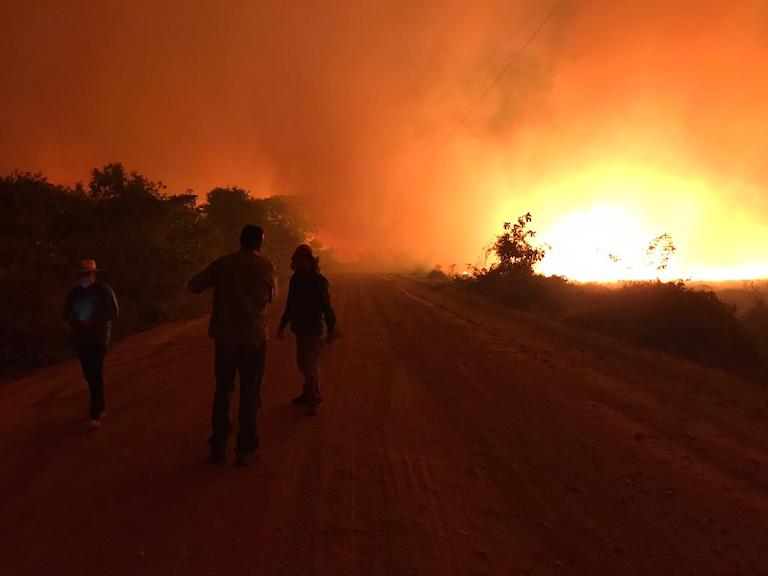Wildlife death toll from 2020 Pantanal fires tops 17 million, study finds
Dec 17, 2021
- A new study has found that nearly 17 million animals died in the Pantanal fires in 2020.
- The researchers came to this estimate by conducting distance sampling surveys, walking tracts of the Pantanal shortly after the fires and counting the number of dead vertebrates they encountered.
- However, the researchers say this is likely to be an underestimate since animals may have died underground or may have died later from burn injuries.
- The 2020 fires burned 4.5 million hectares (11 million acres) of the Pantanal, which is about 30% of the entire biome.
In 2020, fires tore across the Pantanal, the world’s largest wetland region that spans across Brazil, Bolivia and Paraguay. By the time the year drew to a close, the fires had impacted about 4.5 million hectares (11 million acres), which accounts for 30% of the biome and covers nearly 22 times the area lost to fire between 2000 and 2018. As firefighters and volunteers worked to fight the flames, they found jaguars with feet burned so badly they couldn’t walk, tapirs with red patches of scorched skin, and the bodies of crocodiles that weren’t able to run away fast enough.
Now scientists have figured out how many vertebrates lost their lives during the Pantanal fires in 2020. According to a new study published in Scientific Reports, nearly 17 million vertebrates, including snakes, birds and armadillos, perished in the fires.
“The numbers we estimated did not surprise me so much,” lead author Walfrido Tomas, from the Pantanal branch of the Brazilian Agricultural Research Corporation (Embrapa), told Mongabay in an email. “Given the large scale and intensity of the wildfires, as well as the abundance of wildlife in the Pantanal, the results were expected to be huge.”
The researchers came to this estimate by conducting distance sampling surveys, working with local crews to walk along tracts of the Pantanal and counting the number of dead animals they encountered. Between August and November 2020, they surveyed nearly 115 kilometers (71 miles) of the Pantanal, visiting some sites shortly after fires had burned through.

Tomas said it was challenging to work so close to the fires. “Extremely high temperatures, clouds of ashes, and risks related to underground fires [were] considerable,” he said.
The team was able to identify more than 300 animals on a species or genus level “despite the poor condition of most carcasses.” Most of the dead animals were snakes, birds and rodents, but they also found primates, caimans and anteaters.
The number of animals found to have died in the 2020 Pantanal fires was “astonishing,” the researchers say. However, they note it’s likely to be an underestimate since some animals may have died underground, while others may have died at a later point due to burns, a loss of food or increased predation as animals became displaced. Additionally, the authors argue that the impact of the 2020 Pantanal fires “may be stronger for small populations or species that require more time to recover.”
Tomas said it’s still not clear how the fires and loss of life will affect the Pantanal ecosystem in the long run.
“No one knows,” he said. “We accounted for animals directly killed by the fires, but many surely died afterwards from body burnings, starvation and predation. These we will never know. Also, the invertebrates were certainly strongly affected, but there is no data on this impact. The data, however, clearly suggest a profound impact, which may work as a cascade effect affecting entire ecosystems.”

While fire is known to occur naturally in the Pantanal, experts say most of the 2020 fires started from slash-and-burning farming practices. However, climate change and ongoing drought is believed to be exacerbating the situation by making the Pantanal drier and more prone to fire.
Fires flared up again in the Pantanal in 2021, burning more than 700,000 hectares (1.7 million acres) by September, but it’s not clear how many animals it impacted.
“In 2021, the fire hit a much smaller region of the Pantanal, something below 10% if compared with 2020,” Tomas said. “Some areas, however, coincide with the areas burned in 2020, and this is bad news due to the cumulative impacts.”
“The loss of 17 million animals in the Brazilian Pantanal is a tragedy that should take the global community’s breath away,” study co-author Fernando Tortato, a conservation scientist for the NGO Panthera, said in a statement. “With the likelihood of increased wildfire frequency and intensity not only in the Pantanal ecosystem but across the globe due to climate change, it is critically important to do all that we can to reverse course and prevent the millions of deaths of our planet’s extraordinary wildlife species.”
Citation:
Tomas, W. M., Berlinck, C. N., Chiaravalloti, R. M., Faggioni, G. P., Strüssmann, C., Libonati, R., … Morato, R. (2021). Distance sampling surveys reveal 17 million vertebrates directly killed by the 2020’s wildfires in the Pantanal, Brazil. Scientific Reports, 11(1). doi:10.1038/s41598-021-02844-5
Banner image caption: A researcher conducts a transect survey to estimate the number of vertebrates that died in the 2020 fires in the Pantanal.